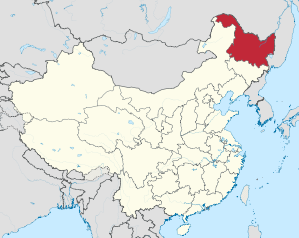Heilongjiang
| Abbreviation : 黑 ( Pinyin : Hēi) | |
| Capital | Harbin |
|
surface - Total |
Rank 6 out of 33 460,000 km² |
|
population
- Total 2016 |
Rank 15 out of 33
37,990,000 inhabitants |
| Management type | province |
| governor | Wang Wentao |
| ISO-3166-2 code | CN-HL |
| District level | 12 cities, 1 administrative district |
| District level | 54 city districts, 45 districts, 21 cities, 1 autonomous district |
| Community level | 443 large communities, 477 communities, 393 street districts, 56 nationality communities |
Heilongjiang ( Chinese 黑龍江 省 / 黑龙江 省 , Pinyin Hēilóngjiāng Shěng - "Province of the Black Dragon River ", coll .: 黑龍江 / 黑龙江 , Hēilóngjiāng - "Black Dragon River ") is a province in the northeast of the People's Republic of China . It borders on Russia to the north and east , Jilin Province to the south and Inner Mongolia to the west . Their capital is Harbin .
geography
The most important river is the Amur , whose Chinese name Heilong Jiang gives the province its name . Other important rivers are the Songhua Jiang and the Ussuri . Important mountains are the Great Hinggan Mountains in the extreme northwest and the Small Hinggan Mountains in the north and northeast.
The province is divided into twelve prefecture-level cities and one administrative district:
- Harbin City (哈尔滨 市),
- Daqing City (大庆 市),
- City of Hegang (鹤岗 市),
- City of Heihe (黑河 市),
- Jiamusi City (佳木斯 市),
- Jixi City (鸡西 市),
- Mudanjiang City (牡丹江 市),
- Qiqihar City (齐齐哈尔 市),
- Qitaihe City (七台河 市),
- Shuangyashan City (双鸭山 市),
- City of Suihua (绥化 市),
- Yichun City (伊春 市),
- Region of greater khingan (大兴安岭地区).
Biggest cities
The population figures are based on the 2010 census and refer to the actual urban settlement. In 2014, 58% of the population lived in cities or urban areas.
| rank | city | Residents | rank | city | Residents |
|---|---|---|---|---|---|
| 1 | Harbin | 4,596,313 | 6th | Yichun | 694.019 |
| 2 | Daqing | 1,433,698 | 7th | Jiamusi | 631.357 |
| 3 | Qiqihar | 1,314,720 | 8th | Hegang | 600.941 |
| 4th | Mudanjiang | 790.623 | 9 | Qitaihe | 503,678 |
| 5 | Jixi | 746.889 | 10 | Shuangyashan | 481.110 |
history
The province was captured by the Imperial Japanese Army in 1931 . She had slipped this into the puppet government of Manchukuo . During World War II , Japan set up Unit 731 , a secret facility of the Kwantung Army , here. She carried out experiments on living people here , killing several thousand people in this way. At the end of the war in 1945, when the production facilities were destroyed by the Japanese army, rats infected with the plague were released, which caused an epidemic in the province and also in Jilin with over 20,000 deaths.
Demography and Autonomy
About 95% of the population are Han Chinese, about 0.3% of the population are Muslim Hui Chinese . The Manchus make up just under 3% of the population, Koreans around 1%, but only 0.4% Mongolians have an autonomous district in Dorbod (Daqing).
Between the two world wars, there was a significant community of Russian exiles in Harbin. Among the Russians, on the other hand, there were several thousand Jews who had fled Russia, whose leader Abraham Kaufman , like the Russian “whites”, collaborated with the Japanese. The Fugu plan in this regard , however, failed due to Japanese repression against the Jewish emigrants in Harbin.
Population development
Population development in the province since 1964.
| year | population |
|---|---|
| 1964 census | 20.118.271 |
| 1982 census | 32,665,546 |
| 1990 census | 35.214.873 |
| 2000 census | 36.237.576 |
| 2010 census | 38.313.991 |
| Guess 2016 | 37,990,000 |
economy
In 2015, the province had a GDP of 1.51 trillion yuan (242 billion US dollars), ranking 21st among the provinces of China. The GDP per capita was 40,498 yuan (US $ 6,097 / PPP : US $ 11,661) per year (21st place among Chinese provinces). The level of prosperity in the province was thus roughly on par with Tunisia and was 75% of the Chinese average.
The province's economy is strongly influenced by the local heavy industry.
tourism
Russian restaurants and bread bakeries give the cityscape of the provincial capital Harbin a little Russian flair: at the end of the 19th century and after the October Revolution , many Russians lived here.
In southern China's Harbin is now known as the City of Ice , because since 1963, the place every year on January 5 Eislaternenfest instead. Sculptures are created from blocks of ice and illuminated in color.
Web links
Individual evidence
- ↑ Heilongjiang (China): Province, Cities & Counties - Population Statistics, Maps, Graphics, Weather and Web Information. Retrieved December 12, 2017 .
- ↑ China: Provinces and Major Cities - Population Statistics, Maps, Charts, Weather, and Web Information. Retrieved May 6, 2018 .
- ^ National Data. Retrieved December 4, 2017 .
Coordinates: 48 ° 8 ' N , 125 ° 41' E


